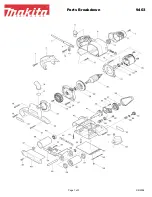
RANDOM ORBITAL
POLISHER
EN
8
a)
Have your power tool serviced by a qualified repair person using only identical replacement parts. This will ensure that the
safety of the power tool is maintained.
8.12.1.102
Additional safety instructions for all operations Kickback and Related Warnings
Kickback is a sudden reaction to a pinched or snagged rotating wheel, backing pad, brush or any other accessory.
Pinching or snagging causes rapid stalling of the rotating accessory which in turn causes the uncontrolled tool to be
forced in the direction opposite of the accessory’s rotation at the point of the binding. For example, if an abrasive wheel is
snagged or pinched by the workpiece, the edge of the wheel that is entering into the pinch point can dig into the surface of
the material causing the wheel to climb out or kick out. The wheel may either jump toward or away from the operator,
depending on direction of the wheel’s movement at the point of pinching. Abrasive wheels may also break under these
conditions.
Kickback is the result of tool misuse and/or incorrect operating procedures or conditions and can be avoided by taking
proper precautions as given below.
a)
Maintain a firm grip on the tool and position your body and arm to allow you to resist kickback forces. Always use
auxiliary handle, if provided, for maximum control over kickback or torque reaction during start-up. The operator can
control torque reactions or kickback forces, if proper precautions are taken.
b)
Never place your hand near the rotating accessory. Accessory may kickback over your hand.
c)
Do not position your body in the area where tool will move if kickback occurs. Kickback will propel the tool in direction
opposite to the wheel’s movement at the point of snagging.
d)
Use special care when working corners, sharp edges etc. Avoid bouncing and snagging the accessory. Corners, sharp
edges or bouncing have a tendency to snag the rotating accessory and cause loss of control or kickback.
e)
Do not attach a saw chain woodcarving blade or toothed saw blade. Such blades create frequent kickback and loss of
control.
CORRECT USAGE
-
This tool is designed to be used as a polisher. Read all the warnings, instructions, indications provided on drawings
and specifications supplied with this tool
. Failure to comply with all the instructions provided below may cause electrical
shocks, fire and/or serious injuries.
-
This tool is not intended to be used for smoothing, metal brushing and cutting operations
. The use of this tool for
unintended applications may cause hazards and injuries to people.
-
The tool must be used with accessories that have been specifically designed or recommended by the manufacturer
.
The fixing of the accessory to the tool does not guarantee a safe operation.
-
The rated speed of the accessories must be at least equivalent to the maximum speed specified on the tool
. Using the
accessories at speeds above the rated one, may cause them to break or be projected into the air.
-
The external diameter and thickness of the accessories must match the specifications of the tool
. Accessories with
incorrect dimensions cannot be adequately protected or controlled.
-
The configuration of accessories must match the tool.
The use of accessories that cannot be perfectly fitted on the tool
may result in imbalance, excessive vibrations and in the impossibility of controlling the tool.
-
Do not use damaged accessories. Before use, inspect all the accessories. Inspect the supporting pads and verify there
are no cracks, tears or excessive wear. If the tool or accessory has fallen, verify that it is not damaged or install a
new accessory. After inspecting or installing an accessory, test the operation of the tool at maximum speed and
without load for one minute, keeping at a safety distance
. If the accessories are damaged, they will break during this
test.
SPECIFIC SAFETY WARNINGS
Verify that no loosened part of the polishing tool shroud or the locking ties can rotate freely. Safely position or cut all the
loosened fixings. Loosened or revolving fixings may twist around the operator’s fingers or get caught by the work piece being
machined.
STARTING UP
Voltage and power frequency must match the data displayed on the identification plate. Make sure that tool is switched
off before plug is connected.
ACCESSORIES ASSEMBLY
BACKING PAD
Use the hex spanner (
8
) to fit the backing pad (
6
).
POLISHING DISC
Apply pressure on polishing disc (
9
) to join disc to backing pad (
6
). Use polishing foam disc up to Ø150 mm.































